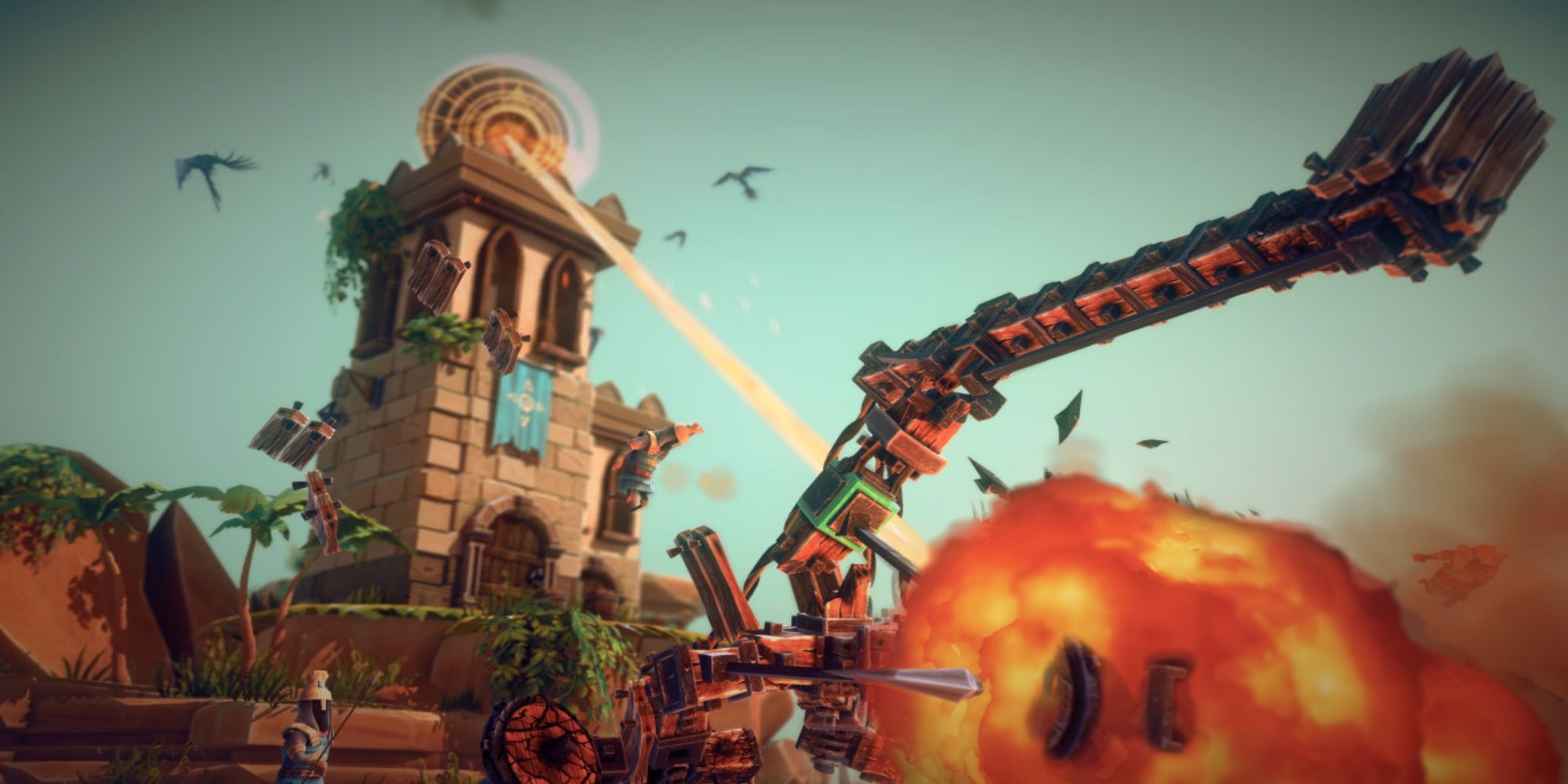
Summary
- The potential of sandbox games is limited by segmented levels, hindering scale and interconnected open-world experiences.
- Transitioning sandbox titles to open-world formats can unlock emergent complexity, deeper player agency, and genre-defining status.
- Games like TABS, Teardown, and Oxygen Not Included could benefit from expansive open-world designs to enhance gameplay depth.
Sandbox games thrive on creativity, experimentation, and player-driven goals, but not all sandbox experiences fully embrace open-world design. Some keep their boundaries tight, focusing on discrete levels or isolated environments. This can limit their potential, especially when their systems beg for sprawling, interconnected spaces.
While structured design can enhance focus and polish, a true open-world framework unlocks scale, emergent complexity, and deeper player agency. Many games already offer remarkable freedom within limited confines, so expanding their scope to open-world formats could elevate them into genre-defining titles to be enjoyed for many years to come.
Totally Accurate Battle Simulator (TABS)
A Physics Playground Begging For The Open Plains
Totally Accurate Battle Simulator (TABS) delivers chaotic sandbox combat through exaggerated ragdoll physics and AI-driven unit clashes. Players design armies from a wide roster and pit them against enemies in bite-sized arenas. The game thrives on unpredictability and humorous outcomes, offering nearly limitless experimentation through mod support and a custom battle editor.
Yet, its segmented level structure curtails larger ambitions. An open-world war sandbox, with faction bases, roaming armies, and territory control, could take its slapstick warfare to unprecedented levels. Bringing in the ability to travel to a sprawling battlefield, discovering hidden units, building fortresses, or witnessing dynamic conflicts across a persistent map could make the whole experience feel even more satisfying than it already does.
Teardown
Destruction With No Limits But The Level Itself
Teardown blends voxel-based destruction with heist-style missions, tasking players with strategically demolishing buildings and escaping elaborate setups. The destructibility is unmatched, as walls collapse realistically, fire spreads, and environments crumble based on physics, turning every mission into a sandbox puzzle shaped by player ingenuity.
However, the mission-based structure anchors this creativity to linear maps. Transitioning to an open-world city or island complex, where missions are discovered organically, buildings evolve, and destruction has long-term consequences, would turn Teardown into the ultimate physics-driven simulation, elevating the core gameplay loop dramatically.
Oxygen Not Included
Colonization That Needs Expansion
Oxygen Not Included is a deep space-colony management sim where players guide duplicants through subterranean survival. Its brilliance lies in complex interlocking systems, such as oxygen flow, heat management, plumbing, automation, and resource logistics. It’s a triumph of system-driven gameplay within a 2D slice of a planet.
Unfortunately, that vertical shaft is limiting. A planet-wide, open-world environment layered with biomes, hazards, and rival colonies could radically expand the game’s scope. While the DLC does introduce a snippet of this kind of gameplay, there is still room to go further beyond just a few planets and into an entire universe.
LittleBigPlanet 3
Infinite Creativity Within The Confines Of Basic Levels
LittleBigPlanet 3 excels as a creative sandbox, giving players the tools to design intricate platformers, puzzles, and entire mini-games. The intuitive editor, community sharing, and whimsical art style encourage experimentation and collaboration, effectively turning it into a game engine disguised as a side-scrolling adventure.
That said, the grid-based, level-centric format restricts immersion. An open-world LittleBigPlanet, where creations exist within a seamless universe, could revolutionize its creative potential. Players might discover community-built towns, mini-games, and platforming challenges naturally, rather than loading into isolated levels, turning Sackboy’s universe into a playable metaverse of user-generated magic.
Poly Bridge 2
Roads Cut Too Short
Poly Bridge 2 is a puzzle-based engineering simulator that allows players to construct bridges to overcome physics-based transportation challenges. Creativity flourishes in the design process, with structural integrity, budget constraints, and vehicle behaviors all requiring clever solutions.
Yet, each puzzle exists in isolation. Therefore, an open-world road-building game, where bridges connect towns that evolve over time and face environmental factors such as weather or traffic, could transform the game into a dynamic civil engineering experience. With real-time logistics and structural persistence, bridge-building would feel far more meaningful rather than simply a set of puzzles.
Besiege
Medieval Mayhem Within A Compact Arena
- Release Date: 18 Feb, 2020
- Developers: Spiderling Studios
- Platforms: PlayStation 5, PlayStation 4, Xbox Series S and X, Xbox One, Nintendo Switch, PC, macOS, Linux
- OpenCritic: 75% Recommend
Besiege invites players to build siege engines and wreak havoc on medieval armies and fortresses. Its flexible building tools, physics-driven destruction, and mod support make it a staple for inventive players. The campaign provides structured missions, while sandbox mode allows for more freeform design.
Despite its creative power, Besiege is locked into small-scale missions and segmented maps. A true open-world Besiege, where players can roam a massive kingdom, assault castles, defend villages, and gather parts, would transform it into a dynamic war simulator that retains all the original DNA. The core systems already invite conquest, and all they need is an open world to conquer.
Instruments Of Destruction
Pure Mayhem That Still Feels Restricted
Instruments of Destruction puts powerful vehicle-based demolition tools in players’ hands, and each level is a sandbox for destruction. Players build machines, knock down structures, and refine designs to maximize chaos. The physics and damage modeling are impressive, offering satisfying feedback loops with each collapse.
However, its level-based structure restricts the long-term utility of its mechanics. An open-world island or larger area filled with corporate targets, moving convoys, and environmental challenges could make destruction feel purposeful. Expanding destruction into logistics or even territory control would allow the engineering systems to shine over a longer time-frame, opening the doors for even more explosive action.
Hitman World Of Assassination
Open Areas That Could Use Even More Freedom
Hitman World of Assassination is built on meticulously crafted sandbox levels, offering players immense freedom to eliminate targets through stealth, sabotage, or chaos. Each mission is a clockwork world, full of strategies and tactics for players to achieve their various objectives in the most effective way possible.
However, each location is sealed off from the next, with no continuity, no in-between travel, and no open-world persistence. Expanding Hitman into an interconnected open world, where targets move between regions, consequences carry over, and long-term strategy matters, would evolve it into a true assassination simulator that could take the series and genre to new heights.
#Sandbox #Games #Arent #OpenWorld

